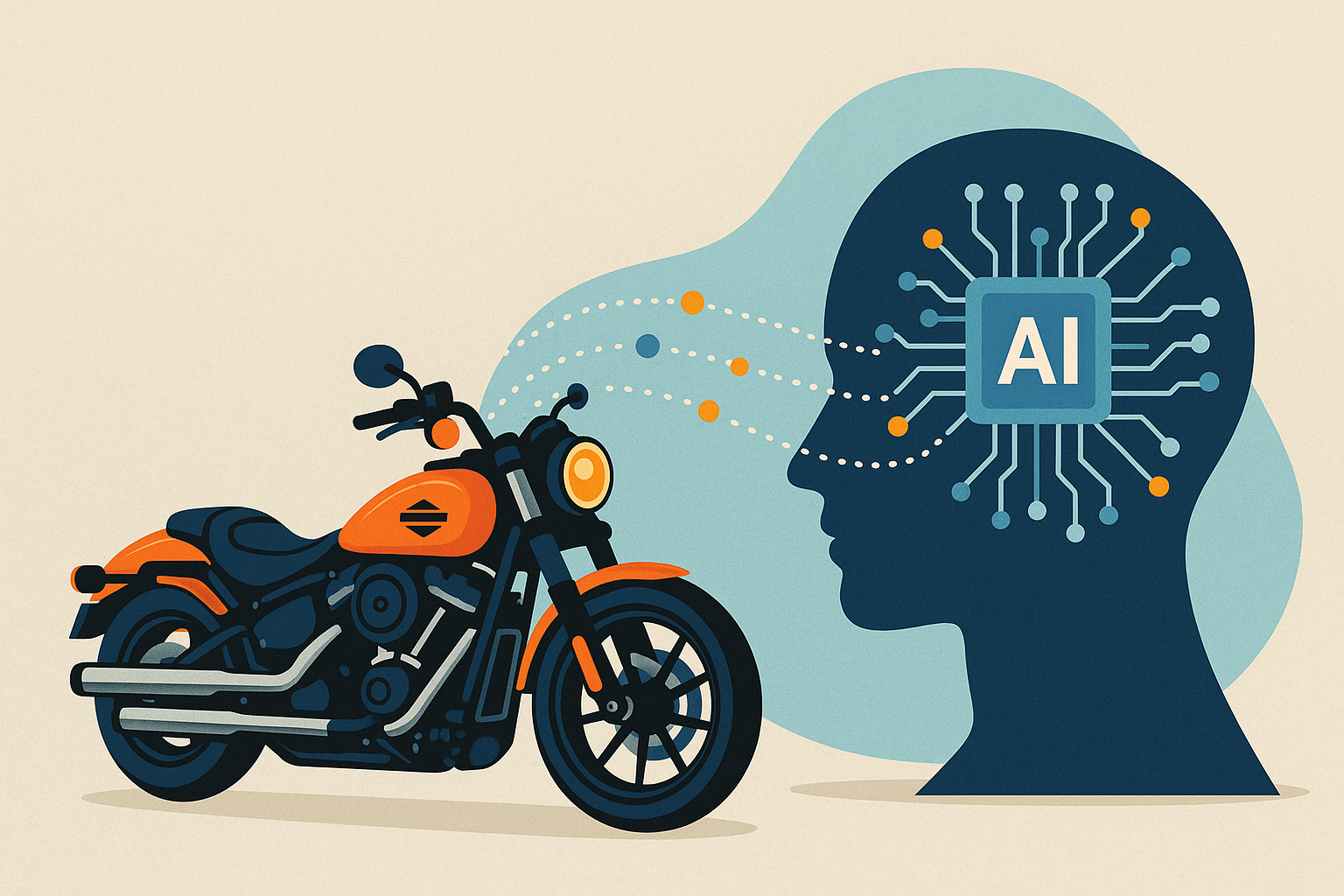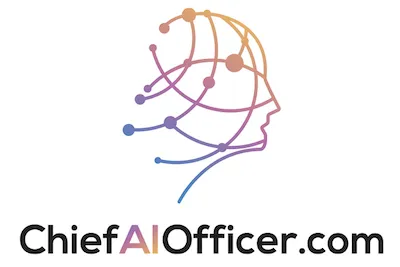Harley-Davidson’s advertising traditionally cast wide nets: billboards along highways, magazine spreads in enthusiast publications, television spots during sports events. Spend millions reaching millions of people, most of whom would never consider buying a $20,000 motorcycle, hoping enough actual prospects saw the ads to justify the expense.
Their AI-powered advertising strategy flipped this model completely. Instead of broadcasting messages hoping to find buyers, AI analyzed real-time customer behavior data to identify people already showing high purchase intent, then automatically delivered targeted ads specifically to them. The results: 40% increase in qualified leads within three months and a 2,930% return on ad spend.
That ROAS number deserves emphasis. For every dollar spent on advertising, Harley-Davidson generated $29.30 in revenue. Not just any revenue, but revenue from qualified leads that converted to actual motorcycle sales. Traditional advertising achieving even 500% ROAS would be considered exceptional. Harley-Davidson’s AI strategy achieved nearly six times that.
The fundamental insight: advertising’s biggest problem isn’t creative quality or message positioning. It’s targeting. Even the best ad wastes money when shown to people who won’t buy. AI didn’t make Harley-Davidson’s ads better. It made sure the right people saw them.
The Traditional Advertising Waste Problem
Harley-Davidson spent millions annually on advertising before AI implementation, with unclear returns on investment. Marketing teams knew advertising was necessary for brand awareness and lead generation but couldn’t precisely determine which spending drove actual sales and which was wasted on irrelevant audiences.
Traditional demographic targeting used approximations: show motorcycle ads to males aged 35-65 with household incomes over $75,000 who expressed interest in motorcycles or outdoor recreation. This targeting seemed logical but remained extremely broad. Millions of people fit these criteria without any actual intent to purchase motorcycles in the near future.
The result was systematic waste. Ads reached people who liked the idea of motorcycles but would never buy one, people who already owned Harleys and didn’t need another, people at the wrong stage of their purchase journey, and people interested in completely different motorcycle styles than Harley-Davidson offered.
Even worse, traditional advertising couldn’t identify the small percentage of prospects actually ready to buy. Someone researching motorcycles extensively, visiting dealer websites, comparing models, and reading reviews represented far higher purchase probability than someone who clicked “like” on a motorcycle video once six months ago. But traditional targeting treated both equally, showing the same ads with the same frequency.
The inability to distinguish high-intent prospects from casual browsers meant Harley-Davidson spent roughly equal advertising dollars on both groups. The person ready to buy next week received the same ad exposure as someone who might consider purchasing in five years. This misallocation wasted budget on low-probability targets while under-serving the high-probability prospects who actually needed additional persuasion to complete purchases.
The targeting problem also created frequency issues. High-intent prospects might see ads once or twice then purchase independently, missing opportunities for additional influence. Low-intent browsers might see ads dozens of times, wasting impressions on people unlikely to convert regardless of frequency. Neither pattern optimized for conversion or efficiency.
Harley-Davidson needed to identify which specific individuals showed genuine purchase intent right now and concentrate advertising spend on that audience rather than spreading it across everyone vaguely interested in motorcycles. Only AI could analyze the behavioral signals at scale necessary to make these distinctions accurately.
The Behavioral Intent Identification
Harley-Davidson’s AI analyzed real-time customer behavior data to identify high-intent prospects based on actions that predicted imminent purchase likelihood. This behavioral analysis went far beyond simple demographic targeting to understand actual purchase readiness.
The system tracked digital footprints indicating serious purchase consideration: repeat visits to Harley-Davidson websites, time spent comparing specific models, engagement with financing calculators, dealer locator usage, request for test ride information, and interaction with inventory listings. These behaviors correlated strongly with near-term purchase probability.
The AI also analyzed behavior patterns across the broader internet beyond just Harley-Davidson properties. People researching motorcycle insurance, watching motorcycle review videos, reading owner forums, and comparing pricing across multiple motorcycle brands showed much higher purchase intent than casual browsers. By tracking these signals, the AI identified prospects Harley-Davidson wouldn’t have known existed through traditional targeting.
The behavioral analysis incorporated time-decay weighting where recent actions mattered more than historical behavior. Someone who visited Harley-Davidson’s website daily for the past week showed higher intent than someone who visited once six months ago, even if the historical visitor spent more total time on site. This recency weighting ensured the AI prioritized current high-intent prospects rather than people whose interest had cooled.
The system also identified behavior sequences that predicted purchase. Certain patterns (researching multiple models, then focusing on specific models, then checking local dealer inventory, then using financing calculators) indicated prospects moving through consideration stages toward purchase decisions. Identifying people in late-stage consideration enabled targeting them at optimal moments for final persuasion.
The behavioral intent scoring happened continuously in real-time. As prospects exhibited new behaviors, their intent scores updated immediately, allowing the AI to begin targeting them within minutes of showing high-intent signals rather than waiting for overnight batch processing like traditional systems.
I’ve observed similar behavioral intent modeling in B2B marketing where companies analyzing prospect website behavior achieved 3-5x higher conversion rates by targeting based on engagement patterns rather than just demographic fit. The key insight is that what people do predicts purchase probability far more accurately than who they are.
The Automated Ad Delivery System
Once the AI identified high-intent prospects, automated systems delivered targeted advertising directly to them across multiple channels without requiring manual campaign management. This automation enabled real-time response to prospect behavior that human teams couldn’t match.
The system determined optimal ad creative for each prospect based on their specific behaviors and position in the purchase journey. Someone researching touring motorcycles saw ads featuring Harley-Davidson’s touring models with messages about comfort for long rides. Someone interested in cruisers saw different creative emphasizing style and heritage. This dynamic creative matching ensured relevance rather than showing generic ads to everyone.
The automation also optimized ad frequency for each prospect. High-intent prospects might see ads daily across multiple channels to maintain top-of-mind awareness during their active shopping period. Medium-intent prospects saw ads less frequently to avoid waste. The system automatically adjusted frequency based on continued behavioral signals, increasing exposure as intent strengthened or reducing it as interest cooled.
The channel selection also adapted automatically. If a prospect primarily used mobile devices, ads concentrated on mobile-optimized channels. If they primarily browsed desktop, the mix shifted accordingly. The system even identified optimal times of day for each prospect based on their typical browsing patterns, scheduling ad delivery when they were most likely to be actively online.
The budget allocation happened dynamically too. As the AI identified new high-intent prospects, it automatically increased spending to reach them while reducing spend on prospects showing declining intent. This continuous reallocation ensured budget concentrated on the highest-probability targets at any given moment rather than being locked into static campaign allocations.
The automation also enabled rapid testing and optimization. The system continuously experimented with different ad creative, messaging, channels, and timing, measuring which combinations drove highest conversion rates for different prospect segments. Successful approaches scaled automatically while underperforming variations got eliminated without human intervention.
The 2,930% ROAS Achievement
The 2,930% return on ad spend represents one of the highest ROAs ever documented in automotive marketing. Understanding how this return was calculated and what it represents provides context for the achievement’s significance.
ROAS measures revenue generated per dollar spent on advertising. A 2,930% ROAS means that for every $1,000 spent on ads, Harley-Davidson generated $29,300 in motorcycle sales revenue. This doesn’t account for profit margins or other costs, but it demonstrates that advertising spend directly drove revenue far exceeding its cost.
The calculation likely tracked customers from ad exposure through dealer visit, test ride, and ultimate purchase. Attribution modeling connected specific ad impressions to final sales, ensuring credit went to advertising that actually influenced purchases rather than coincidentally reaching people who would have bought anyway.
The exceptional ROAS came from both increasing conversion rates (more prospects who saw ads actually purchased) and reducing wasted spend (fewer ad dollars going to people who wouldn’t purchase). The combination created multiplicative improvements where better targeting generated more sales from less spending.
Compare this to typical automotive advertising ROAS of 300-500%. Harley-Davidson’s AI-powered approach achieved 6-10 times better returns than industry norms. This advantage came almost entirely from superior targeting rather than better creative or different channels. The ads themselves didn’t change dramatically. Who saw them changed completely.
The ROAS also benefited from Harley-Davidson’s high average sale prices. Motorcycles costing $20,000-$45,000 mean that even modest conversion rate improvements generate substantial revenue. A traditional campaign reaching 100,000 people with 0.1% conversion rate (100 sales) generates similar revenue to AI-targeted campaigns reaching 10,000 high-intent prospects with 1% conversion rate (100 sales), but the latter costs far less to execute.
The three-month timeline for achieving these results also matters. Marketing campaigns often require 6-12 months to show measurable impact as awareness builds and prospects move through consideration stages. Seeing 40% lead increases and exceptional ROAS within three months indicates the behavioral targeting identified prospects already far along in their purchase journeys who just needed final nudges to convert.
The Qualified Lead Quality Improvement
The 40% increase in qualified leads matters more than just the quantity improvement. The “qualified” designation indicates these weren’t just more inquiries but more inquiries from genuine prospects likely to actually purchase.
Traditional advertising generated leads of highly variable quality. Some came from serious buyers actively shopping. Others came from casual browsers with no real purchase intent who requested information out of curiosity. Sales teams wasted time following up with low-quality leads that would never convert, creating frustration and inefficiency.
The AI targeting dramatically improved lead quality by reaching people showing behavioral signals of serious purchase intent. These leads had already self-qualified through their research behaviors before even seeing Harley-Davidson ads. They weren’t just people interested in motorcycles generally. They were people actively shopping for motorcycles right now who needed to be convinced to choose Harley-Davidson over competitors.
The improved lead quality showed up in conversion metrics throughout the sales funnel. Higher percentages of leads scheduled dealer visits, more visitors completed test rides, and more test riders ultimately purchased. These downstream improvements validated that the AI was identifying genuinely high-intent prospects rather than just more people willing to click on ads.
The qualified lead improvement also benefited from better timing. The AI identified prospects at optimal moments in their purchase journeys when they were actively comparing options and ready to engage with dealers. Traditional advertising often reached prospects too early (creating awareness that faded before purchase decisions) or too late (after they’d already decided on competitors).
The Budget Waste Elimination
Beyond generating better results, the AI system dramatically reduced budget waste by not showing ads to people unlikely to purchase. This efficiency improvement meant Harley-Davidson could either achieve similar results with much lower spending or dramatically better results with the same budget by reallocating waste into productive targeting.
Traditional campaigns might show ads to 1 million people, of whom 990,000 had no real purchase intent in the relevant timeframe. Even if the ads were creative masterpieces, showing them to irrelevant audiences wasted 99% of impressions on people who wouldn’t buy regardless of how many times they saw ads.
The AI targeting concentrated spending on the 10,000 people who showed high purchase intent. This 100x focusing of effort meant budget previously wasted on irrelevant audiences now concentrated on genuine prospects. Even if the AI wasn’t perfect and some targets still didn’t purchase, the hit rate improved from 0.1% to 10% or better, representing 100x efficiency improvement.
The waste reduction also came from eliminating redundant ad exposure to people who already decided to purchase. Traditional campaigns continued showing ads throughout lengthy flight periods regardless of whether prospects had already converted. The AI recognized when prospects completed purchases and immediately stopped showing them acquisition ads, eliminating pointless spending.
The dynamic budget reallocation also prevented wasting money on approaches that weren’t working. Traditional campaigns locked budget allocations for campaign durations. If certain creative or channels underperformed, money continued flowing into them until campaign completion. The AI continuously tested and reallocated, ensuring dollars always flowed to the most effective approaches rather than being locked into underperforming strategies.
The Competitive Advantage Creation
Harley-Davidson’s AI targeting created sustainable competitive advantages beyond just immediate advertising efficiency. The capabilities and data accumulated through AI-powered campaigns compound over time, widening gaps with competitors using traditional approaches.
The behavioral data collected about prospect interests, preferences, and purchase patterns improves targeting accuracy continuously. As the AI observes more prospects through their purchase journeys, it refines understanding of which behaviors predict purchases most accurately. This accumulated learning makes targeting progressively better, creating widening performance gaps with competitors starting similar initiatives later.
The competitive advantage also comes from market coverage efficiency. Harley-Davidson can identify and reach high-intent prospects their competitors miss entirely. When someone shows purchase intent behaviors, Harley-Davidson’s AI flags them and begins targeted advertising before competitors even know they exist. This first-mover advantage in prospect engagement affects brand consideration and potentially wins sales that competitors never had opportunity to compete for.
The improved ROAS also provides budget flexibility advantages. Harley-Davidson can profitably outspend competitors on advertising because their superior targeting generates better returns. Competitors achieving 500% ROAS can’t justify matching Harley-Davidson’s spending when their ads generate 1/6 the return. This creates a sustainable spending advantage where Harley-Davidson maintains higher share of voice without requiring proportionally higher budgets.
The capabilities also attract better talent. Marketing professionals want to work with cutting-edge technologies and data-driven approaches. Harley-Davidson’s reputation as a leader in AI-powered marketing helps recruit digital talent that might otherwise gravitate toward pure technology companies rather than traditional manufacturers.
The Marketing Mix Integration
The AI advertising success didn’t exist in isolation. Harley-Davidson integrated it with broader marketing strategies including community engagement, experiential marketing through rallies and events, influencer collaborations, and heritage brand storytelling.
The AI advertising identified prospects, but the broader marketing ecosystem provided the content and experiences that influenced their purchase decisions. Prospects targeted by AI ads might then attend Harley rallies, follow brand influencers, engage with digital content about motorcycle culture, or explore the brand’s heritage narrative. These touchpoints worked together to move prospects from awareness through consideration to purchase.
The integration also provided data synergies. Event attendance, content engagement, and community participation all generated behavioral signals that improved AI targeting. Someone who attended a Harley rally showed much higher purchase intent than someone who just browsed the website once. The AI incorporated these rich behavioral signals to identify the most qualified prospects.
The marketing mix approach also addressed different audience segments appropriately. Younger prospects might discover Harley-Davidson through social media influencers, then get retargeted with AI-powered ads, then engage with digital content before purchasing. Older prospects might start with traditional advertising, attend events, then receive AI-targeted ads during active shopping. The system adapted to different customer journeys rather than forcing everyone through identical funnels.
The Dealer Network Enablement
The qualified leads generated through AI advertising flowed to Harley-Davidson’s dealer network, where sales teams converted online interest into in-person purchases. The lead quality improvement substantially affected dealer operations and success rates.
Dealers historically received leads of highly variable quality requiring extensive qualification before investing sales effort. The AI-generated leads came pre-qualified through behavioral signals, allowing dealers to focus sales efforts on prospects already showing serious purchase intent rather than wasting time on casual browsers.
The lead information also included behavioral insights helpful for sales conversations. Dealers knew which models prospects researched most, what features they spent time examining, and where they were in their purchase journey. This context enabled more relevant sales conversations addressing prospects’ specific interests rather than generic pitches.
The lead timing also improved. Prospects flagged by AI were actively shopping right now rather than being in early research stages that might not lead to purchases for months or years. This timing alignment meant dealer follow-up happened when prospects were ready to engage rather than being premature or late.
The dealer success with AI-generated leads also created positive feedback loops. As dealers saw better conversion rates and easier sales processes with AI leads compared to traditional sources, they provided more feedback and support for the program. This dealer engagement helped refine targeting further and ensured leads received appropriate sales follow-up.
The Technology Stack Reality
Implementing AI-powered advertising at Harley-Davidson’s scale required sophisticated technology infrastructure beyond just buying AI software. Understanding this complexity matters for organizations considering similar approaches.
The system needed real-time data integration across multiple sources: website analytics, CRM systems, dealer management platforms, advertising platforms, and external data providers. Creating unified customer profiles from these disparate sources required substantial data engineering and integration work.
The AI models needed training on historical data to learn which behaviors predicted purchases. This required cleaning and organizing years of customer data, labeling outcomes (which prospects purchased and which didn’t), and running numerous model iterations to achieve acceptable accuracy. This foundational work took months before the system could begin production use.
The advertising platform integrations enabled automated ad delivery across multiple channels. APIs connecting to Google, Facebook, programmatic ad exchanges, and other platforms allowed the AI to trigger campaigns automatically without requiring manual campaign setup for each prospect. These integrations required ongoing maintenance as advertising platforms updated their APIs and policies.
The attribution modeling connecting ad exposure to final sales required sophisticated tracking across online and offline touchpoints. Connecting someone who saw Facebook ads to their eventual dealer visit and purchase required data linking across systems that historically operated independently.
The Privacy and Consent Framework
Behavioral targeting using personal data requires careful attention to privacy regulations and user consent. Harley-Davidson’s implementation needed to comply with privacy laws while still enabling effective targeting.
The system relied on first-party data (information collected directly from users through Harley-Davidson properties) and consented third-party data rather than unauthorized tracking. Users visiting Harley-Davidson websites or engaging with their content agreed to data collection through cookie consent mechanisms and privacy policies.
The behavioral tracking focused on aggregated patterns and purchase-intent signals rather than deeply personal information. The system tracked that someone researched motorcycles extensively, not private details about their life. This focus on purchase-relevant behaviors rather than personal characteristics helped address privacy concerns.
The targeting also operated through platform intermediaries rather than directly exposing user data to Harley-Davidson. When the AI identified a high-intent prospect, it worked through advertising platforms’ targeting mechanisms rather than obtaining personal contact information without consent. This preserved privacy while enabling effective targeting.
Your Strategic Response Path
For marketers in considered-purchase categories (automobiles, motorcycles, recreational vehicles, luxury goods), Harley-Davidson’s success demonstrates that AI-powered behavioral targeting can transform advertising efficiency from cost center to profit driver.
Start by identifying behavioral signals that predict purchase intent in your category. What actions indicate someone is actively shopping right now versus just casually browsing? What research patterns correlate with eventual purchase? These signals form the foundation for AI targeting models.
Audit current advertising waste by analyzing how much spending reaches genuinely high-intent prospects versus irrelevant audiences. This quantifies the opportunity and justifies investment in better targeting capabilities.
Build or buy AI capabilities that can identify high-intent prospects from behavioral signals in real-time. This requires data integration across your digital properties, AI models that can learn from historical patterns, and advertising integrations that enable automated delivery.
Measure results through proper attribution that connects ad exposure to final sales rather than just intermediate metrics like clicks or leads. The full value only becomes clear when tracking through to revenue rather than stopping at lead generation.
The Future of Purchase-Intent Advertising
Automotive and considered-purchase advertising is transitioning from demographic broadcasting to behavioral targeting. The companies that master identifying and reaching high-intent prospects will dominate their categories through superior efficiency and effectiveness.
Harley-Davidson proved that 2,930% ROAS isn’t theoretical. It’s achievable reality when advertising reaches the right people at the right moments with the right messages. The question isn’t whether AI-powered targeting works. It’s whether your organization will implement it while it still provides competitive advantages or wait until competitors force you to catch up from behind.
Achieving 40% more qualified leads and 29x return on ad spend isn’t about revolutionary technology. It’s about solving advertising’s fundamental problem: making sure the people who see your ads are the people ready to buy.




